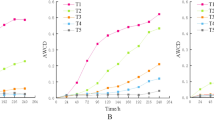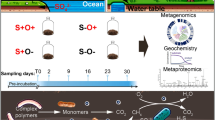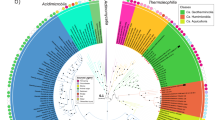Abstract
Effects of extremely high carbon dioxide (CO 2 ) concentrations on soil microbial communities and associated processes are largely unknown. We studied a wetland area affected by spots of subcrustal CO 2 degassing (mofettes) with focus on anaerobic autotrophic methanogenesis and acetogenesis because the pore gas phase was largely hypoxic. Compared with a reference soil, the mofette was more acidic (ΔpH ∼0.8), strongly enriched in organic carbon (up to 10 times), and exhibited lower prokaryotic diversity. It was dominated by methanogens and subdivision 1 Acidobacteria , which likely thrived under stable hypoxia and acidic pH. Anoxic incubations revealed enhanced formation of acetate and methane (CH 4 ) from hydrogen (H 2 ) and CO 2 consistent with elevated CH 4 and acetate levels in the mofette soil. 13 CO 2 mofette soil incubations showed high label incorporations with ∼512 ng 13 C g (dry weight (dw)) soil −1 d −1 into the bulk soil and up to 10.7 ng 13 C g (dw) soil −1 d −1 into almost all analyzed bacterial lipids. Incorporation of CO 2 -derived carbon into archaeal lipids was much lower and restricted to the first 10 cm of the soil. DNA-SIP analysis revealed that acidophilic methanogens affiliated with Methanoregulaceae and hitherto unknown acetogens appeared to be involved in the chemolithoautotrophic utilization of 13 CO 2 . Subdivision 1 Acidobacteriaceae assimilated 13 CO 2 likely via anaplerotic reactions because Acidobacteriaceae are not known to harbor enzymatic pathways for autotrophic CO 2 assimilation. We conclude that CO 2 -induced geochemical changes promoted anaerobic and acidophilic organisms and altered carbon turnover in affected soils.
Similar content being viewed by others
Log in or create a free account to read this content
Gain free access to this article, as well as selected content from this journal and more on nature.com
or
References
Allison VJ, Condron LM, Peltzer DA, Richardson SJ, Turner BL . (2007). Changes in enzyme activities and soil microbial community composition along carbon and nutrient gradients at the Franz Josef chronosequence, New Zealand. Soil Biol and Biochem 39: 1770–1781.
Bankwitz P, Schneider G, Kämpf H, Bankwitz E . (2003). Structural characteristics of epicentral areas in Central Europe: study case Cheb Basin (Czech Republic). J Geodyn 35: 5–32.
Blaser MB, Dreisbach LK, Conrad R . (2013). Carbon isotope fractionation of 11 acetogenic strains grown on H2 and CO2 . Appl Environ Microbiol 79: 1787–1794.
Blume HP, Felix-Henningsen P . (2009). Reductosols: Natural soils and Technosols under reducing conditions without an aquic moisture regime. J Plant Nutr Soil Sci 172: 808–820.
Bräuer K, Kämpf H, Niedermann S, Strauch G, Weise SM . (2004). Evidence for a nitrogen flux directly derived from the European subcontinental mantle in the Western Eger Rift, Central Europe. Geochim Cosmochim Acta 68: 4935–4947.
Bräuer SL, Cadillo-Quiroz H, Yashiro E, Yavitt JB, Zinder SH . (2006). Isolation of a novel acidiphilic methanogen from an acidic peat bog. Nature 442: 192–194.
Bräuer SL, Cadillo-Quiroz H, Ward RJ, Yavitt JB, Zinder SH . (2011). Methanoregula boonei gen. nov., sp. nov. an acidiphilic methanogen isolated from an acidic peat bog. Int J Syst Evol Microbiol 61: 45–52.
Cadillo-Quiroz H, Bräuer S, Yashiro E, Sun C, Yavitt J, Zinder S . (2006). Vertical profiles of methanogenesis and methanogens in two contrasting acidic peatlands in central New York State, USA. Environ Microbiol 8: 1428–1440.
Callaway TR, Dowd SE, Wolcott RD, Sun Y, McReynolds JL, Edrington TS et al. (2009). Evaluation of the bacterial diversity in cecal contents of laying hens fed various molting diets by using bacterial tag-encoded FLX amplicon pyrosequencing. Poult Sci 88: 298–302.
Chan Y, Nostrand JDV, Zhou J, Pointing SB, Farrell RL . (2013). Functional ecology of an Antarctic Dry Valley. Proc Natl Acad Sci USA 110: 8990–8995.
Clark ID, Fritz P . (1997) Environmental isotopes in hydrogeology. CRC Press/Lewis Publishers: Boca Raton, USA.
Conrad R . (2005). Quantification of methanogenic pathways using stable carbon isotopic signatures: a review and a proposal. Org Geochem 36: 739–752.
Daims H, Brühl A, Amann R, Schleifer KH, Wagner M . (1999). The domain-specific probe EUB338 is insufficient for the detection of all Bacteria: development and evaluation of a more comprehensive probe set. Syst Appl Microbiol 22: 434–444.
Date Y, Nakanishi Y, Fukuda S, Kato T, Tsuneda S, Ohno H et al. (2010). New monitoring approach for metabolic dynamics in microbial ecosystems using stable-isotope-labeling technologies. J Biosci Bioeng 110: 87–93.
DeLong EF . (1992). Archaea in coastal marine environments. Proc Natl Acad Sci USA 89: 5685–5689.
Drake HL, Horn MA, Wüst PK . (2009). Intermediary ecosystem metabolism as a main driver of methanogenesis in acidic wetland soil. Environ Microbiol Reports 1: 307–318.
Drake L, Küsel K, Matthies C . (2013). Acetogenic prokaryotes. In: Rosenberg E, DeLong EF, Lory S, Stackebrandt E, Thompson F, (eds) The Prokaryotes: Prokaryotic Physiology and Biochemistry 4th edn. Springer: Berlin Heidelberg, pp 3–60.
Eiler A . (2006). Evidence for the ubiquity of mixotrophic bacteria in the upper ocean: Implications and consequences. Appl Environ Microbiol 72: 7431–7437.
Elvert M, Boetius A, Knittel K, Jørgensen BB . (2003). Characterization of specific membrane fatty acids as chemotaxonomic markers for sulfate-reducing bacteria involved in anaerobic oxidation of methane. Geomicrobiol J 20: 403–419.
Ertefai TF, Heuer VB, Prieto-Mollar X, Vogt C, Sylva SP, Seewald J et al. (2010). The biogeochemistry of sorbed methane in marine sediments. Geochim Cosmochim Acta 74: 6033–6048.
Flechsig C, Bussert R, Rechner J, Schütze C, Kämpf H . (2008). The Hartousov mofette soil field in the Cheb Basin, Western Eger Rift (Czech Republic): a comperative geoelectric, sedimentologic and soil gas study of a magmatic diffuse CO2-degassing structure. Z Geol Wiss 36: 177–193.
Foesel BU, Rohde M, Overmann J . (2013). Blastocatella fastidiosa gen. nov., sp. nov., isolated from semiarid savanna soil – The first described species of Acidobacteria subdivision 4. Syst Appl Microbiol 36: 82–89.
Frerichs J, Oppermann BI, Gwosdz S, Möller I, Herrmann M, Krüger M . (2012). Microbial community changes at a terrestrial volcanic CO2 vent induced by soil acidification and anaerobic microhabitats within the soil column. FEMS Microbiol Ecol 84: 60–74.
Gelwicks JT, Risatti JB, Hayes JM . (1989). Carbon isotope effects associated with autotrophic acetogenesis. Org Geochem 14: 441–446.
Gelwicks JT, Risatti JB, Hayes JM . (1994). Carbon isotope effects associated with aceticlastic methanogenesis. Appl Environ Microbiol 60: 467–472.
Hädrich A, Heuer VB, Herrmann M, Hinrichs K-U, Küsel K . (2012). Origin and fate of acetate in an acidic fen. FEMS Microbiol Ecol 81: 339–354.
He Z, Xu M, Deng Y, Kang S, Kellogg L, Wu L et al. (2010). Metagenomic analysis reveals a marked divergence in the structure of belowground microbial communities at elevated CO2 . Ecol Lett 13: 564–575.
Henderson G, Naylor GE, Leahy SC, Janssen PH . (2010). Presence of novel, potentially homoacetogenic bacteria in the rumen as determined by analysis of Formyltetrahydrofolate Synthetase sequences from ruminants. Appl Environ Microbiol 76: 2058–2066.
Herrmann M, Hädrich A, Küsel K . (2012). Predominance of thaumarchaeal ammonia oxidizer abundance and transcriptional activity in an acidic fen. Environ Microbiol 14: 3013–3025.
Heuer V, Elvert M, Tille S, Krummen M, Mollar XP, Hmelo LR et al. (2006). Online δ13C analysis of volatile fatty acids in sediment/porewater systems by liquid chromatography-isotope ratio-mass spectrometry. Limnol Oceanogr: Methods 4: 346–357.
Heuer VB, Pohlman JW, Torres ME, Elvert M, Hinrichs KU . (2009). The stable carbon isotope biogeochemistry of acetate and other dissolved carbon species in deep subseafloor sediments at the northern Cascadia Margin. Geochim Cosmochim Acta 73: 3323–3336.
Heuer VB, Krüger M, Elvert M, Hinrichs KU . (2010). Experimental studies on the stable carbon isotope biogeochemistry of acetate in lake sediments. Org Geochem 41: 22–30.
Horn MA, Matthies C, Küsel K, Schramm A, Drake HL . (2003). Hydrogenotrophic methanogenesis by moderately acid-tolerant methanogens of a methane-emitting acidic peat. Appl Environ Microbiol 69: 74–83.
Hug LA, Castelle CJ, Wrighton KC, Thomas BC, Sharon I, Frischkorn KR et al. (2013). Community genomic analyses constrain the distribution of metabolic traits across the Chloroflexi phylum and indicate roles in sediment carbon cycling. Microbiome 1: 22.
Hügler M, Sievert SM . (2011). Beyond the Calvin Cycle: Autotrophic carbon fixation in the ocean. Annu Rev Mar Sci 3: 261–289.
Hunger S, Schmidt O, Hilgarth M, Horn MA, Kolb S, Conrad R et al. (2011). Competing formate- and carbon dioxide-utilizing prokaryotes in an anoxic methane-emitting fen soil. Appl Environ Microbiol 77: 3773–3785.
Inagaki F, Suzuki M, Takai K, Oida H, Sakamoto T, Aoki K et al. (2003). Microbial communities associated with geological horizons in coastal subseafloor sediments from the sea of Okhotsk. Appl Environ Microbiol 69: 7224–7235.
Jin VL, Evans RD . (2010). Microbial 13C utilization patterns via stable isotope probing of phospholipid biomarkers in Mojave Desert soils exposed to ambient and elevated atmospheric CO2 . Global Change Biol 16: 2334–2344.
Kämpf H, Geissler WH, Bräuer K . (2007). Combined gas-geochemical and receiver function studies of the Vogtland/NW Bohemia intraplate mantle degassing field, Central Europe. In: Ritter JRR, Christensen UR, (eds) Mantle Plumes. Springer: Berlin Heidelberg, pp 127–158.
Kämpf H, Bräuer K, Schumann J, Hahne K, Strauch G . (2013). CO2 discharge in an active, non-volcanic continental rift area (Czech Republic): Characterisation (δ13C, 3He/4He) and quantification of diffuse and vent CO2 emissions. Chem Geol 339: 71–83.
Koga Y . (2011). Early evolution of membrane lipids: how did the lipid divide occur? J Mol Evol 72: 274–282.
Küsel K, Drake HL . (1994). Acetate synthesis in soil from a Bavarian beech forest. Appl Environ Microbiol 60: 1370–1373.
Küsel K, Dorsch T, Acker G, Stackebrandt E, Drake HL . (2000). Clostridium scatologenes strain SL1 isolated as an acetogenic bacterium from acidic sediments. Int J Syst Evol Microbiol 50: 537–546.
Leschine SB . (1995). Cellulose degradation in anaerobic environments. Annu Rev Microbiol 49: 399–426.
Lin YS, Lipp JS, Yoshinaga M, Lin S-H, Elvert M, Hinrichs KU . (2010). Intramolecular stable carbon isotopic analysis of archaeal glycosyl tetraether lipids. Rapid Commun Mass Spectrom 24: 2817–2826.
Liu XL, Lipp JS, Hinrichs KU . (2011). Distribution of intact and core GDGTs in marine sediments. Org Geochem 42: 368–375.
Liu Y, Yao T, Gleixner G, Claus P, Conrad R . (2013). Methanogenic pathways, 13C isotope fractionation, and archaeal community composition in lake sediments and wetland soils on the Tibetan Plateau. J Geophys Res Biogeosci 118: 650–664.
Lodish H, Baltimore D, Berk A, Zipursky SL, Matsudira P, Darnell J . (1995). Transport across cell membranes. In: Molecular cell biology. Palgrave Macmillan: Houndmills, pp 633–668.
Lovell CR, Przybyla A, Ljungdahl LG . (1990). Primary structure of the thermostable Formyltetrahydrofolate Synthetase from Clostridium thermoaceticum. Biochem 29: 5687–5694.
Lovell CR, Leaphart AB . (2005). Community-level analysis: key genes of CO2-reductive acetogenesis. Meth Enzymol 397: 454–469.
Loy A, Lehner A, Lee N, Adamczyk J, Meier H, Ernst J et al. (2002). Oligonucleotide microarray for 16S rRNA gene-based detection of all Recognized lineages of sulfate-reducing prokaryotes in the environment. Appl Environ Microbiol 68: 5064–5081.
Ludwig W, Strunk O, Westram R, Richter L, Meier H, Yadhukumar et al. (2004). ARB: a software environment for sequence data. Nucleic Acids Res 32: 1363–1371.
Matin A . (1978). Organic nutrition of chemolithotrophic bacteria. Annu Rev Microbiol 32: 433–468.
Miltner A, Richnow H-H, Kopinke F-D, Kästner M . (2004). Assimilation of CO2 by soil microorganisms and transformation into soil organic matter. Org Geochem 35: 1015–1024.
Miltner A, Kopinke FD, Kindler R, Selesi D, Hartmann A, Kästner M . (2005). Non-phototrophic CO2 fixation by soil microorganisms. Plant and Soil 269: 193–203.
Neufeld JD, Vohra J, Dumont MG, Lueders T, Manefield M, Friedrich MW et al. (2007). DNA stable-isotope probing. Nat Protocols 2: 860–866.
Oppermann BI, Michaelis W, Blumenberg M, Frerichs J, Schulz HM, Schippers A et al. (2010). Soil microbial community changes as a result of long-term exposure to a natural CO2 vent. Geochim Cosmochim Acta 74: 2697–2716.
Pfanz H, Vodnik D, Wittmann C, Aschan G, Raschi A . (2004). Plants and geothermal CO2 exhalations - Survival in and adaptation to a high CO2 environment. In: Esser K, Lüttge U, Beyschlag W, Murata J, (eds) Progress in Botany Vol 65. Springer: Berlin Heidelberg, pp 499–538.
Pruesse E, Quast C, Knittel K, Fuchs BM, Ludwig W, Peplies J et al. (2007). SILVA: a comprehensive online resource for quality checked and aligned ribosomal RNA sequence data compatible with ARB. Nucl Acids Res 35: 7188–7196.
Reiche M, Torburg G, Küsel K . (2008). Competition of Fe(III) reduction and methanogenesis in an acidic fen. FEMS Microbiol Ecol 65: 88–101.
Reith F, Drake HL, Küsel K . (2002). Anaerobic activities of bacteria and fungi in moderately acidic conifer and deciduous leaf litter. FEMS Microbiol Ecol 41: 27–35.
Rennert T, Eusterhues K, Pfanz H, Totsche KU . (2011). Influence of geogenic CO2 on mineral and organic soil constituents on a mofette soil site in the NW Czech Republic. Eur J Soil Sci 62: 572–580.
Ross DJ, Tate KR, Newton PCD, Wilde RH, Clark H . (2000). Carbon and nitrogen pools and mineralization in a grassland gley soil under elevated carbon dioxide at a natural CO2 spring. Global Change Biol 6: 779–790.
Sait M, Davis KER, Janssen PH . (2006). Effect of pH on isolation and distribution of members of subdivision 1 of the phylum Acidobacteria occurring in soil. Appl Environ Microbiol 72: 1852–1857.
Šantrůčková H, Bird MI, Elhottová D, Novák J, Picek T, Šimek M et al. (2005). Heterotrophic fixation of CO2 in Soil. Microb Ecol 49: 218–225.
Schloss PD, Westcott SL, Ryabin T, Hall JR, Hartmann M, Hollister EB et al. (2009). Introducing mothur: Open-source, platform-independent, community-supported software for describing and comparing microbial communities. Appl Environ Microbiol 75: 7537–7541.
Selesi D, Schmid M, Hartmann A . (2005). Diversity of green-like and red-like ribulose-1,5-bisphosphate carboxylase/oxygenase large-subunit genes (cbbL) in differently managed agricultural soils. Appl Environ Microbiol 71: 175–184.
Selesi D, Pattis I, Schmid M, Kandeler E, Hartmann A . (2007). Quantification of bacterial RubisCO genes in soils by cbbL targeted real-time PCR. J Microbiol Methods 69: 497–503.
Springer E, Sachs MS, Woese CR, Boone DR . (1995). Partial gene sequences for the A subunit of Methyl-Coenzyme M Reductase (mcrI) as a phylogenetic tool for the family Methanosarcinaceae. Int J Syst Bacteriol 45: 554–559.
Takai K, Horikoshi K . (2000). Rapid detection and quantification of members of the archaeal community by quantitative PCR using fluorogenic probes. Appl Environ Microbiol 66: 5066–5072.
Teske A, Sørensen KB . (2008). Uncultured archaea in deep marine subsurface sediments: have we caught them all? ISME J 2: 3–18.
Vodnik D, Maček I, Videmšek U, Hladnik J . (2007). The life of plants under extreme CO2 . Biol Acta Slov 50: 31–39.
Ward NL, Challacombe JF, Janssen PH, Henrissat B, Coutinho PM, Wu M et al. (2009). Three genomes from the phylum Acidobacteria provide insight into the lifestyles of these microorganisms in soils. Appl Environ Microbiol 75: 2046–2056.
Wasmund K, Schreiber L, Lloyd KG, Petersen DG, Schramm A, Stepanauskas R et al. (2014). Genome sequencing of a single cell of the widely distributed marine subsurface Dehalococcoidia, phylum Chloroflexi. ISME J 8: 383–397.
Watanabe K, Kodama Y, Hamamura N, Kaku N . (2002). Diversity, abundance, and activity of archaeal populations in oil-contaminated groundwater accumulated at the bottom of an underground crude oil storage cavity. Appl Environ Microbiol 68: 3899–3907.
Weinlich FH, Tesar J, Weise SM, Bräuer K, Kämpf H . (1998). Gas flux distribution in mineral springs and tectonic structure in the western Eger Rift. J Geosci 43: 91–110.
Weinlich FH, Bräuer K, Kämpf H, Strauch G, Tesař J, Weise SM . (2003). Gas flux and tectonic structure in the western Eger Rift, Karlovy Vary–Oberpfalz and Oberfranken, Bavaria. Geolines 15: 181–187.
Whitman W, Boone D, Koga Y, Keswani J . (2001). Taxonomy of methanogenic archaea. In: Bergey’s Mannual of Systematic Bacteriology. Springer: Heidelberg, pp 211–294.
Yuan H, Ge T, Chen C, O’Donnell AG, Wu J . (2012). Significant role for microbial autotrophy in the sequestration of soil carbon. Appl Environ Microbiol 78: 2328–2336.
Acknowledgements
We thank Xavier Prieto Mollar for assistance during lipid and stable isotope analysis; Jenny Wendt, Heike Geilmann and Martin Nowak for assistance with TOC and δ13C-TOC analysis; Alexander Schulze, Carsten Simon and Carolin Neubert for help during sampling; and Steffen Kolb and Anke Hädrich for helpful discussions and comments on the manuscript. This work was funded by the Deutsche Forschungsgemeinschaft through grant KU1367/10-1 and through the Gottfried Wilhelm Leibniz Prize to Kai-Uwe Hinrichs.
Author information
Authors and Affiliations
Corresponding author
Ethics declarations
Competing interests
The research presented in this manuscript was conducted in the absence of any commercial or financial relationships that could be construed as a potential conflict of interest. Any use of trade, product, or firm names is for descriptive purposes only and does not imply endorsement by the U.S. Government.
Additional information
Supplementary Information accompanies this paper on The ISME Journal website
Supplementary information
Rights and permissions
About this article
Cite this article
Beulig, F., Heuer, V., Akob, D. et al. Carbon flow from volcanic CO2 into soil microbial communities of a wetland mofette. ISME J 9, 746–759 (2015). https://doi.org/10.1038/ismej.2014.148
Received:
Revised:
Accepted:
Published:
Issue date:
DOI: https://doi.org/10.1038/ismej.2014.148
This article is cited by
-
Responses of soil nutrients and microbial communities to intercropping medicinal plants in moso bamboo plantations in subtropical China
Environmental Science and Pollution Research (2020)
-
Thermoplasmatales and sulfur-oxidizing bacteria dominate the microbial community at the surface water of a CO2-rich hydrothermal spring located in Tenorio Volcano National Park, Costa Rica
Extremophiles (2019)
-
Microbial Community Level Physiological Profiles of Active Mud Volcano Soils in Andaman and Nicobar Islands
National Academy Science Letters (2018)
-
Altered carbon turnover processes and microbiomes in soils under long-term extremely high CO2 exposure
Nature Microbiology (2016)



